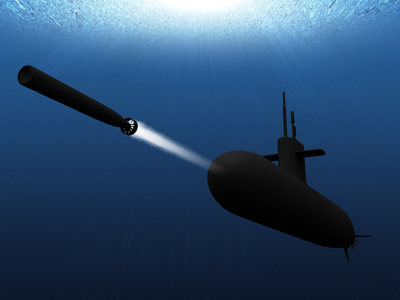
Ask the AI Tutor
Need help with Naval Warfare? Ask our AI Tutor!
AI Tutor - Lucy
Connecting with Tutor...
Please wait while we establish connection

The submarine had its first major success during World War One.
Naval Warfare
Naval Warfare is all about ships and submarines.
During the nineteenth century Great Britain was the largest naval power in the world. The German government sought to build a navy to match that of the British and a naval arms race began. These two great navies would face each other at the outbreak of war.
1 .
The British ship, HMS Dreadnought, was the first of a new kind of battleship. It outclassed previous battleships in which respects?
Firepower, armour and speed
Firepower and armour
Speed and firepower
Armour and speed
The Dreadnought was faster than previous battleships because it used steam turbines, rather than steam engines. It was also better armed, having 5 twin 12-inch guns to use against enemy ships and 27 smaller 12-pdr guns to use against torpedo boats
2 .
Despite the influence of HMS Dreadnought on the design of battleships, she took no part in battles during WWI. She did, however, become the only battleship to achieve which feat?
Sink a submarine
Sail around the world
Sink a battleship
Bombard the German coastline
The German U-boat, SM U-29 was rammed by HMS Dreadnought when it surfaced after firing on another battleship. After this, HMS Dreadnought was assigned to coastal defence and saw no more action. She was sold for scrap in 1921
3 .
British Battlecruisers differed from their Dreadnought cousins in which way?
They had thicker armour but were slower
They were faster but had smaller guns
They had bigger guns but were slower
They were faster but had less armour
The lack of armour saved weight and so increased speed. The idea behind Battlecruisers was that they could out-gun anything smaller than them and out-run anything larger
4 .
Which type of craft were considered as the greatest threat to the Dreadnought battleships?
U-Boats
Torpedo Boats
Other Dreadnoughts
Cruisers
Torpedo Boats were small, fast, difficult to hit and cheap. Mass attacks could theoretically overwhelm a fleet of Dreadnoughts
5 .
To counter these smaller craft, a mid-sized ship was developed. What was it called?
U-Boat
Frigate
Destroyer
Cruiser
Torpedo Boat Destroyers, as they were originally called, were developed solely to intercept torpedoes and to keep the Torpedo Boats away from larger ships. Their speed and shallow displacement of water made them difficult targets for torpedoes
6 .
The submarine had its first major success during World War One. How many Allied ships were sunk by German U-Boats?
Two thousand ships
Three thousand ships
Four thousand ships
Five thousand ships
The poor range and speed of submarines made them unsuitable for battle. Although a few small to medium-sized British warships were sunk by U-Boats, the vast majority of their prey were merchant ships
7 .
Which type of ship was used to counter the threat of submarines?
Destroyers
Battleships
Cruisers
Submarines
The Destroyers' speed meant that they could attack U-Boats when on the surface by ramming, and Destroyer's bows were strengthened for this purpose. They were also equipped with hydrophones to locate submerged U-Boats and depth-charges to attack them with
8 .
During World War One, oil began to replace coal as the fuel for warships. This gave the ships greater range and which other benefit?
They were faster
They were lighter
They were more manoeuvrable
They were less visible to the enemy
Oil gave off much less smoke than coal when it was burned. This made ships powered by oil less conspicuous to the enemy. However, convoys and fleets usually contained a mixture of ships, both coal and oil powered, so the advantage was seldom given its full effect
9 .
Great Britain laid naval mines all along its east coast, the Straits of Dover and northern exits of the North Sea to protect it from German ships. How many mines are estimated to have been used?
90,000 mines
145,000 mines
190,000 mines
245,000 mines
82 ships worked day and night for five months to clear the mines after the war had ended, such was the enormity of the task
10 .
The first battleship to be sunk during the War was HMS Audacious, on 27th October 1914 off the north coast of Donegal, Ireland. How was it sunk?
It was torpedoed by a German U-Boat
It ran into a German mine
It was torpedoed by a German Torpedo Boat
It was gunned by a German Battleship
Despite having a crew of 500 men, there was only one fatality. Shells on the ship exploded as it sank, sending pieces of wreckage flying through the air. One of these hit a petty officer aboard the HMS Liverpool, 800 yards away and killed the unfortunate fellow
**Unlimited Quizzes Await You! 🚀**
Hey there, quiz champ! 🌟 You've already tackled today's free questions.
Ready for more?
Ready for more?
🔓 Unlock UNLIMITED Quizzes and challenge yourself every day. But that's
not all...
not all...
🔥 As a Subscriber you can join our thrilling "Daily Streak" against other
quizzers. Try to win a coveted spot on our Hall of Fame Page.
quizzers. Try to win a coveted spot on our Hall of Fame Page.
Don't miss out! Join us now and keep the fun rolling. 🎉
**Unlimited Quizzes Await You! 🚀**
Hey there, quiz champ! 🌟 You've already tackled today's free questions. Ready for more?
🔓 Unlock UNLIMITED Quizzes and challenge yourself every day. But that's not all...
🔥 As a Subscriber you can join our thrilling "Daily Streak" against other quizzers. Try to win a coveted spot on our Hall of Fame Page.
Don't miss out! Join us now and keep the fun rolling. 🎉






